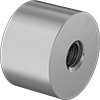Filter by
Diameter
System of Measurement
Tolerance Rating
Hardness
Mechanical Finish
Hardness Rating
Specifications Met
Heat Treatment
DFARS Specialty Metals
Steel Grade
Yield Strength
Edge Type
Maximum Temperature
Minimum Temperature
Raw Materials
Power Transmission




































